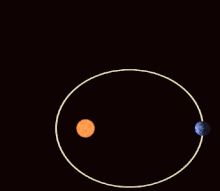Astrodynamics/Perturbations
| This page was last edited on 15 July 2024, and is still under heavy construction. Content that is added is likely to be moved/deleted/edited significantly in a short amount of time. All Wikibookians with knowledge in this subject are welcome to help out. You can remove this tag when the book has become more mature. |
Perturbations in astrodynamics refers to the forces that act on an object that is not from the gravitational attraction of a single, more massive body. These forces can include gravity from other bodies, drag from an atmosphere(Such as the decay of satellite orbits because of collisions with gas molecules and the craft), or the off center attraction caused by an oblate or irregularly shaped body.
Orbital resonance
[edit | edit source]Orbital resonance is when large bodies regularly perturb other bodies with gravity. This usually ends in instability in which the orbits of the two bodies are shifted until there is no more resonance. In some cases the resonant system can be self correcting, making the resonance stable. Examples of this are the 2:3 resonance between Neptune and Pluto and the 1:2:4 resonance between Jupiter's moons of Ganymede, Europe and Io.
Apsidal precession
[edit | edit source]
Apsidal precession is the precession of the line of apsides of an object's orbit. It is related with the orbit's argument of periapsis. It is caused by perturbations from other bodies in the system, and by gravity perturbations explained by general relativity.